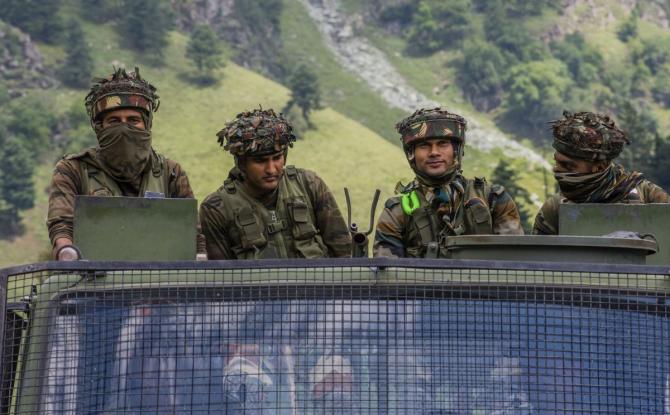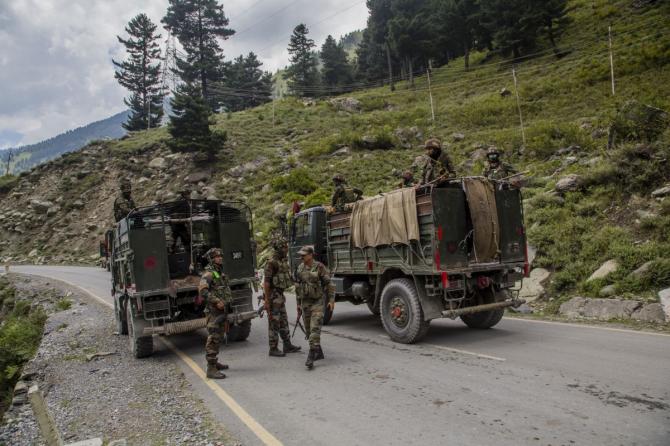'India of 2020 is a wake-up call for China'
by ARCHANA MASIH'The leverage created by the Indian military must not be lost.'

IMAGE: An Indian Army convoy carrying reinforcements and supplies heads to Ladakh, September 2, 2020. Photograph: Yawar Nazir/Getty Images
"The Indian soldier has a clear advantage to the Chinese because of his valour and ferocity."
"Troops are well-prepared mentally, morally and operationally to confront and overcome a tough winter," says Lieutenant General A B Shivane, PVSM, AVSM, VSM (retd) in the second part of a must-read interview with Rediff.com's Archana Masih.
- Part 1: 'China has received a setback'
With Indian troops occupying dominating heights in Chishul, do you think it has provided greater leverage to India to negotiate more aggressively with the Chinese on the diplomatic table?
The leverage created by the military must not be lost. Theissue should be addressed in a balanced manner.
At the same time, the Chinese will also look for a face-saving opportunity. Therefore, we should be very clear that a buffer zone is not acceptable because we cannot withdraw into our own land.
Since the perceptions of the LAC differ, what prevents the Chinese from coming to Finger 4 tomorrow and demanding that we retreat by 20 kilometres?
Even if we agree to go back to the April positions, we must take a commitment from the Chinese of a methodology, institutional mechanisms and time frame for addressing the delimitation and demarcation of LAC.
There must be a mechanism where they inform us when they conduct exercises so that they don't enter our area under the garb of an exercise
My recommendation to the political hierarchy is to include military representatives in the delegations while talking to the Chinese.
Firstly, it sends a strategic message.
Secondly, it speaks well of the political, diplomatic and military harmony which defines the national security calculus of a self-respecting nation.
How will the firing on the LAC alter the ground situation and the rules of engagement?
The rules of engagement exist for both sides.
By using barbaric means and primitive weapons, the Chinese broke the existing rules and widened the trust deficit.
The rules of engagement have been totally altered post Galwan because of the Chinese action on June 15.
In the process, India has transitioned from following a reactive defensive strategy to being proactive and pre-emptive.
The Indian soldier's motivation and training is of very high standard and is unmatched by the Chinese.
The Indian soldier has seen blood and bullets. He has a high level of motivation, ferocity and valour.
Our leadership at the tactical level is very high. While the PLA is very politicised and lacks will and courage.
The Chinese are very conscious of their body bags. They call themselves a global power, but do not give respect to their fallen soldiers.
When we lose our soldiers, we honour them and their families throughout our lifetime.
The India of 2020 is certainly a wake-up call for the Chinese.
They need to realise that the Indian soldier has a clear advantage to the Chinese, irrespective of technology, because of his valour and ferocity.
Technology can be acquired, borrowed and collaborated, but the man on the ground cannot be replaced.

IMAGE: An Indian Army convoy on its way to Ladakh, September 2, 2020. Photograph: Yawar Nazir/Getty Images
Winter is approaching and this is something that the Chinese also are mindful of because their foreign ministry has mentioned the weather challenges ahead. What challenge does it throw for us in terms of men, material and armament?
Winter stocking is done routinely, but with the infusion of additional forces, let me assure you, not with statistics, but with military knowledge, that infrastructure and build-up is taking place at a very high pace to make sure that winter stocking, ammunition, administrative/ operational requirements and habitat construction are all taken care of.
We are well prepared mentally and morally to confront and overcome a tough winter.
What roles do tanks play in such high-altitude warfare?
Tanks are a critical component of our credible deterrence.
During my tenure I have visited each of these operational locations and have been part of perspective planning, capability building, future threats, operational planning and philosophy.
We have done detailed analysis of all the sectors along the LAC looking at locations where tanks and mechanised forces can be employed.
I would say we are well placed quantitatively and adequately.
Tanks in high altitude are a critical factor of battle winning.
Integrated battle groups for the mountains both for defensive and offensive operations are a force multiplier.
Today, the Spanggur Gap has been dominated by the T 90 tanks. T 90 has better survivability and a distinct qualitative advantage over the Chinese T 59 tank.
But we also need to look into future capabilities of the light tanks which I have extensively spoken, written and professed.
The mainstay can be medium tanks, but there needs to be a certain quantum of lights tanks to be utilised in those gaps and corridors where medium tank employment is restricted.

IMAGE: Lieutenant General A B Shivane, who served as director general mechanised forces. Photograph: Kind courtesy Lieutenant General A B Shivane
In your experience, what do you think irks the Chinese about India's military preparedness?
One is the build-up of the Andaman and Nicobar Command in the sea.
Second is the build-up of our mechanised forces on the northern borders.
Third, the employment of Brahmos missiles.
Fourth, the building of infrastructure particularly of our air fields and air strips along the LAC.
As a military man, how do you see the next couple of months ahead? Do you think a stand-down is imminent, or do feel there is going to be further escalation?
It is not going to be a fast forward solution.
Hopefully, sensibility will prevail against an all-out war.
The situation is tense because both sides are sitting opposite each other with weaponry and armaments, and an irresponsible spark can escalate, but strategically, war as a solution is not the option.
What I see happening is that diplomacy will take its time and winters are here to stay. In the intervening period, there will be pinprick actions to keep the prestige and leverage by both sides till a diplomatic solution arrives.
And hopefully that solution will be a very balanced solution like I mentioned earlier.
Till then, I think we are going to see an active LAC.
The last and the most important issue which I'm sure the security apparatus has already done is that we need to be prepared all across the northern, eastern and central front with very high level of operation readiness, sustainment and further incremental improvement.
Unfortunately, we have a history of being surprised repeatedly after Independence. Hopefully, we have learned our lessons.
We should occupy criticalities, enhance monitoring and hope for the best and prepare for the worst.
Feature Presentation: Aslam Hunani/Rediff.com